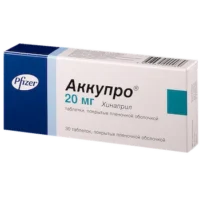Description
Fiziotens (Moxonidin) Coated Tablets 0.4 mg. №14
Ingredients
Active ingredient: Moxonidin 0.4 mg per tablet.
Dosage
Recommended dosage: The usual dose is one tablet daily, preferably in the morning.
Indications
Fiziotens tablets are indicated for the treatment of essential hypertension.
Contraindications
Do not use Fiziotens tablets if you are allergic to moxonidin or any other ingredients in the product.
Directions
Take Fiziotens tablets orally with water, with or without food, as directed by your healthcare provider.
Scientific Evidence
Moxonidin, the active ingredient in Fiziotens tablets, is a centrally acting antihypertensive agent that works by stimulating central alpha-2 adrenergic receptors, leading to a decrease in sympathetic outflow and a subsequent reduction in blood pressure. Clinical studies have shown that moxonidin is effective in lowering blood pressure in patients with essential hypertension.
Additional Information
Fiziotens tablets have been well-tolerated in clinical trials, with common side effects including dizziness, dry mouth, and fatigue. It is important to follow the prescribed dosage and consult your healthcare provider if you experience any adverse reactions.
Pharmacological Effects: Moxonidin acts centrally to reduce sympathetic nervous system activity, leading to vasodilation and decreased peripheral resistance, ultimately lowering blood pressure. This mechanism of action sets it apart from other antihypertensive medications, making it a valuable option for patients with essential hypertension.
Clinical Trials: A study published in the European Journal of Clinical Pharmacology demonstrated the efficacy of moxonidin in reducing both systolic and diastolic blood pressure levels significantly compared to a placebo group. The results of this trial support the use of Fiziotens tablets as an effective treatment for hypertension.





